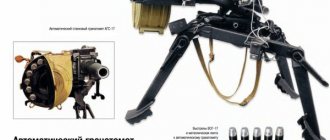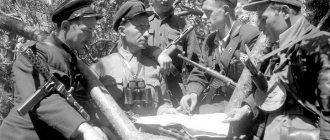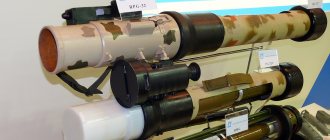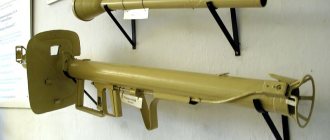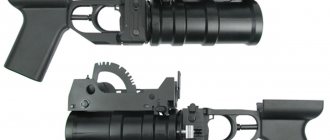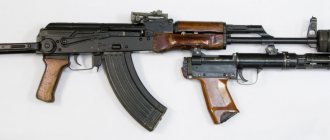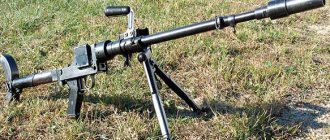Underbarrel grenade launcher GP-25 "Koster"
AK-74M with GP-25. Photo selection-2. GP-25 “Bonfire” grenade launcher. Photo selection-2. Soldiers with a GP-25 grenade launcher. Photo selection-1.
In this article you will get acquainted with one of the Soviet/Russian 40-mm under-barrel grenade launchers-GP25 (GRAU-6G15), which has its own name “Koster”. The grenade launcher is installed on Kalashnikov assault rifles AK, AKM, AK-74. For firing from a grenade launcher, 40-mm VOG-25 fragmentation grenade launcher rounds and other rounds are used. This type of weapon is designed to destroy enemy infantry in shelters, as well as unarmored vehicles, including on reverse slopes of terrain by firing along an overhead trajectory.
History of creation
In the 60s, during the Vietnam conflict, our soldiers were able to obtain samples of M16 rifles, which were equipped with an M203 grenade launcher. The very idea of an under-barrel grenade launcher as such attracted the attention of the USSR Ministry of Defense, since there was no production of such a weapon at that time in the Soviet Union. However, after testing the provided M203, it was noted that their characteristics were unsatisfactory and a more advanced sample was needed. So, in 1971, a task program was created to create an under-barrel grenade launcher, which was called “OKR Koster”, a continuation of the Iskra program. This program was provided to all design bureaus of the Soviet Union. When this project was studied at the design bureau of the Tula Arms Plant, its development was entrusted to Valery Nikolaevich Telesh, one of the best designers in this field. He involved the engineers of the State Research and Production Enterprise “Pribor” from Moscow in the creation of a model of a grenade launcher, and began work in 1972. In 1978, after a cycle of state tests, the GP-25 was put into service. According to the technical documentation, it was supposed to be used with AKM, AKMS, AK-74, AKS-74 and subsequent AK series projects. At GRAU the sample received the index 6G15. Design index of the prototype TKB-0121 (pictured above). This under-barrel grenade launcher began to arrive en masse in 1980, when the USSR began fighting in Afghanistan. There he received very positive feedback from those using it, since it gave undeniable advantages over the enemy in shelters (trenches, trenches, etc.). The grenade launcher significantly increased the firepower of the soldiers. Now the soldier could confidently hit the enemy with a grenade, who was located 100-400 meters away from him, which was impossible when throwing a regular fragmentation grenade of the F-1 or RGD-5 type. Also, the effectiveness of throwing grenades is limited to: a distance of 30-40 meters (you also need to take into account the fatigue of the fighter), the inconvenience of throwing, the accuracy of the throw, the height of the obstacle. Yes, and don’t forget about the development of the 40-mm Iskra under-barrel grenade launcher, created in 1970. The OVG-40 fragmentation-cumulative round was created especially for Iskra. This project failed due to the fact that senior military officials wanted from a 40-mm grenade launcher the effectiveness of an anti-tank grenade launcher capable of penetrating the armor of medium tanks, and in terms of fragmentation effectiveness against enemy personnel, like a full-fledged fragmentation grenade. Armor penetration of 50 mm at an angle of 90 degrees turned out to be insufficient for the military; the project was curtailed. And after 2 years, the military for some reason revived the project, already under the name “OCR Kostre”. Valery Nikolaevich Telesh often appeared to test the Iskar underbarrel grenade launcher, which allowed him to see real problems and shortcomings and collect information that he used when creating his Iskar grenade launcher.
The grenade launcher has a very simple design and consists of:
- a barrel on which a bracket for attaching to a machine gun and a sighting system for firing are immediately installed;
- breech;
- trigger mechanism (trigger mechanism) with a safety lock.
In addition, the grenade launcher comes with:
- a bag for carrying a grenade launcher (GRAU-6Sh47) if it is not attached to the machine gun;
- a bag for grenade launcher shots (GRAU 6Sh48), now in addition to this, new unloading vests for soldiers provide additional pockets for GP shots;
- a rubber butt plate and a belt for the machine gun to reduce recoil when fired from a grenade launcher mounted on the machine gun;
- Banner for cleaning the barrel of a grenade launcher from gunshot residue:
- a guide rod for the return spring with an additional latch for AK and AKM assault rifles, so that the receiver cover does not fly off after a shot; this latch was installed at the factory on the AK-74 assault rifle.
general characteristics
GP-25 “Bonfire” is designed to destroy enemy personnel who are located in open areas or in shelters (trenches, trenches), and, thus, cannot be hit from conventional small arms.
Weapons to which the under-barrel grenade launcher can be attached are AK-74, AKM, AKMS and AKS-74U in 7.62 or 5.45 mm caliber. How does the entire structure work when assembled? In this case, depending on the current situation in battle, it is possible to fire from both a machine gun and a grenade launcher.
Technical idea of GP-25/6G15
The barrel of the grenade launcher has 12 right-hand rifling (the VOGi-25 itself has hooks for rifling) for twisting the grenade and imparting stability in flight, thereby increasing the accuracy and accuracy of the battle. It also has a special retainer installed that keeps the loaded grenade from falling out of the barrel in all positions; an extractor in the form of a rod is also connected to it for extracting unfired FOGs. In the stowed position (in the bag), it is transferred disassembled to the barrel and breech with the trigger. Before use, it is assembled and correctly attached to the machine gun, since otherwise the complex system of levers will simply block the trigger mechanism. In addition, a butt plate is attached to the machine gun to mitigate recoil. To fire, you need to remove the safety and then pull the trigger. He, in turn, pulls the trigger, which compresses the spring. When the trigger is released, the spring, breaking from the latch, pushes the firing pin connected to it through a hinge. It breaks the capsule, as a result of which the shot itself occurs. Sights consist of a folding rear sight and a movable front sight (for direct fire) and a distance scale with special distance divisions (of the “Quadrant” type for mounted shooting). When setting the distance, a special mechanism shifts the front sight, introducing corrections for deviations of the grenade from external conditions. When shooting with a canopy (mortar shooting), the shooter rests the butt of the machine gun on the ground and fires a shot. To make an aimed shot, the shooter takes aim through the front sight, resting the butt on his shoulder; with such a shot, the shooter feels good recoil; for this reason, shooters often shoot from a grenade launcher, pinching it between the body and elbow, sacrificing the accuracy of the shot. The GP-25 can use VOG-25 and VOG-25P “Foundling” ammunition as its main ammunition. The peculiarity of the latter is that when it hits a surface, it bounces 1.5 m into the air and only then detonates, thereby making it more effective against the enemy in trenches and trenches, as well as in a prone position. VOGi-25 has a fuse that prevents the grenade from exploding if it flies less than 10-40 meters. There is also a self-liquidator that operates after 14-19 seconds if an explosion does not occur after hitting soft surfaces (snow, water, sand, etc.). The peculiarity of VOG-25 explosions is that the grenades have semi-finished fragmentation elements, which create a large number of fragments that inflict many wounds on the enemy, after which the enemy is forced to allocate soldiers to evacuate the wounded to a safe place. In addition, there are various signal, gas and smoke grenades, which provide additional capabilities in the fight against the enemy.
Advantages of the GP-25 underbarrel grenade launcher:
- ease of installation, no adapters required, adjustment of the machine;
- shooting from inconvenient places and positions;
- increasing the firepower of a fighter;
- wide range of 40 mm shots;
- canopy shooting;
- monoblock cartridge case and grenade body, no time required to extract the cartridge case;
- the mass of the grenade launcher improved the accuracy of fire from a machine gun;
- decent firing range (300-400) meters.
- security: the presence of a self-liquidator and a combat platoon through grenades after 10-40 meters at the VOGs.
Disadvantages of GP-25:
- resource 400 shots;
- affects the life of the machine;
- increases the size and weight of the machine gun;
- it is required to calculate and estimate the correction for deviation to the right and to the wind when shooting at 200-400 meters.
Safety and convenience when shooting
Since the under-barrel grenade launcher has much greater recoil than that of an assault rifle, devices are provided that allow firing with comfort for the shooter. A universal rubber butt pad is attached to the butt, and its features are such that it can be adapted both to butts made of wood and plastic (like AK-74 or AKM), and to folding butts of AKMS or AKS-74 assault rifles. The grenade launcher body softens its impact on the fore-end, and its insert protects the receiver from impacts.
Tests in the field revealed an unpleasant feature - when fired, the receiver cover, which is usually attached with the head of the return spring rod, often flew off. Therefore, a special rod was developed, the design of which included a hook. When installing a grenade launcher, the standard rod is replaced with it. In the design of the AK-74M assault rifle, this feature has become standard, that is, all such weapons are produced with a modified rod.
Combat use
The GP-25 “Koster” grenade launcher proved itself well during the war in Afghanistan, and then during the Chechen companies. The last massive use of under-barrel grenade launchers was observed during the military conflict in Ukraine in 2014-2018 by both sides of the conflict. To carry VOG-25s, the military uses special unloading bags for 10 VOGs (
), belt-unloading with carabiners for 10 VOGs (
,
) or vests for 5 VOGs (
). During combat missions, fighters often take a double supply of VOGs (20 VOGs). The debate about the effectiveness of VOGs has always been discussed by fighters; some prefer to use an under-barrel grenade launcher, while others try to take a couple of extra magazines for a machine gun instead. But the widespread use of an under-barrel grenade launcher shows its effectiveness during combat operations. Also, under-barrel grenade launchers are not inferior in their characteristics, and sometimes surpass foreign models of grenade launchers in their class. At the moment, talk that the time of under-barrel grenade launchers has passed is not even discussed due to the lack of a replacement for this type of weapon. Under-barrel grenade launchers are common in the countries of the former USSR; they are rare in other countries of the world, since the USSR did not have time to arm friendly countries of the USSR. The grenade launcher continues to be in service with the Russian Federation even after the adoption of its modernized versions GP-30 and GP-34. In addition to the Russian Federation, the production of grenade launchers was established in Transnistria, Ukraine (GP-25U), Serbia (PBG-40), Bulgaria (UBGL, UBGL-1).
Technical characteristics of GP-25 “Koster”
| Number of charges | 1, reusable |
| Barrel diameter | 40 mm, 205 mm barrel length, 12 rifling |
| Barrel resource | 300-400 shots |
| Combat rate of fire | 4-5 shots per minute |
| Sighting range | 30-300 meters |
| Maximum firing range | 450 meters canopy and 200 direct fire |
| Minimum firing range | 30-40 meters |
| Initial departure speed | 76 m/s |
| Weight | 1.5 kg and 1.76 kg charged |
| Length | 323 mm |
| Types of ammunition | modifications of VOG-25 |
Some features
As you might guess, the grenade launcher weighs down the machine gun it is attached to. A fully equipped AK-74 with GP-25 weighs approximately 5.1 kg. However, this is only beneficial. The center of gravity of the weapon shifts forward and down, that is, if you attach an under-barrel grenade launcher, the AK-74 begins to “lower.” Therefore, the shooter will need some time to get used to the changes in his weapon. However, with the proper level of skill, you can significantly increase the accuracy of a machine gun’s fire, since the weight prevents it from “throwing” in different directions.
Weapon variants and modifications
Since the GP-25 under-barrel grenade launcher also entered service with the troops of the Ministry of Internal Affairs of the Russian Federation, the question arose of how to turn it into a non-lethal weapon. And it was resolved quite quickly. The main changes, of course, affected the ammunition. A special “Nail” cartridge has been developed for the grenade launcher, which is equipped not with a standard fragmentation grenade, but with the same one, but filled with CS type poison gas. The characteristics of such a shot are as follows:
- weight - 170 g;
- maximum shot range - 250 m;
- minimum shot range - 50 m;
- time of complete gas release - 15 seconds;
- cloud volume - 500 m3.
The original idea came from the designers of the Research Institute of the Ministry of Internal Affairs. It was decided to adapt the GP-25 for firing ammunition from the KS-25 carbine - with gas, rubber or plastic bullets. For this purpose, a special removable barrel with a caliber of 23 mm was developed. This system is called "Larry".
In addition to standard models, a modified version is also produced - GP-30. This is the same GP-25 underbarrel grenade launcher, only lighter, and its sighting devices are located on the right side. There is also a modification for export - GP-30U, which is intended for use with foreign assault rifles.

